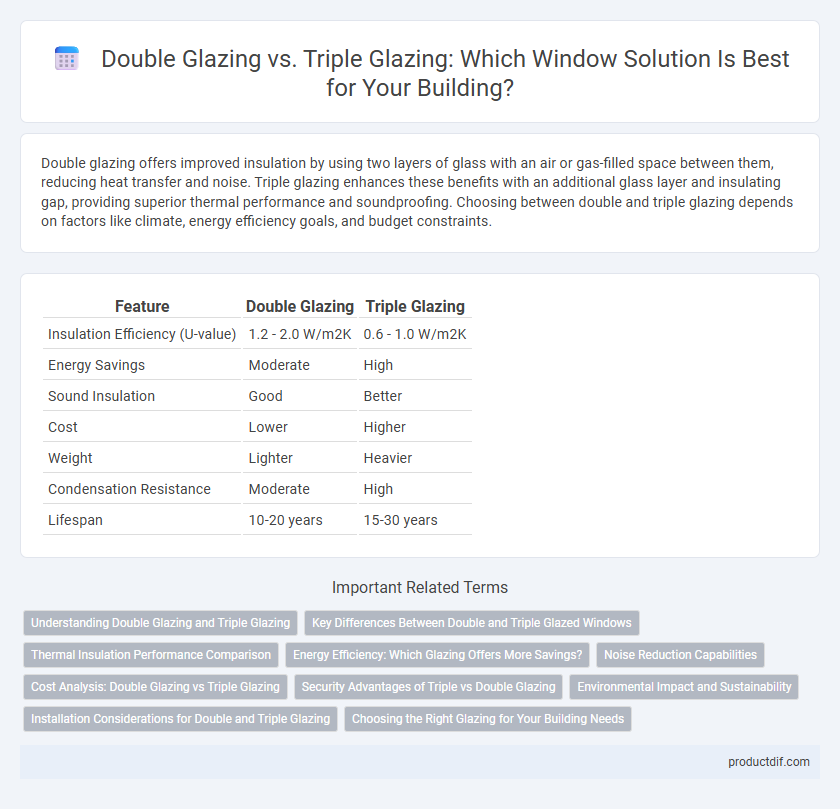Double glazing offers improved insulation by using two layers of glass with an air or gas-filled space between them, reducing heat transfer and noise. Triple glazing enhances these benefits with an additional glass layer and insulating gap, providing superior thermal performance and soundproofing. Choosing between double and triple glazing depends on factors like climate, energy efficiency goals, and budget constraints.
Table of Comparison
| Feature | Double Glazing | Triple Glazing |
|---|---|---|
| Insulation Efficiency (U-value) | 1.2 - 2.0 W/m2K | 0.6 - 1.0 W/m2K |
| Energy Savings | Moderate | High |
| Sound Insulation | Good | Better |
| Cost | Lower | Higher |
| Weight | Lighter | Heavier |
| Condensation Resistance | Moderate | High |
| Lifespan | 10-20 years | 15-30 years |
Understanding Double Glazing and Triple Glazing
Double glazing consists of two panes of glass separated by an air or gas-filled space, providing effective insulation and reducing heat loss compared to single glazing. Triple glazing includes three glass panes with two insulating gaps, offering superior thermal performance, enhanced noise reduction, and increased energy efficiency. Understanding the differences helps in selecting the optimal window solution for climate conditions and energy savings.
Key Differences Between Double and Triple Glazed Windows
Double glazed windows consist of two glass panes separated by a spacer filled with air or inert gas, providing effective insulation and reducing heat transfer. Triple glazed windows add a third pane, enhancing thermal performance and noise reduction but at a higher cost and increased frame weight. Energy efficiency ratings, U-values, and climate considerations are crucial factors in choosing between double and triple glazing for optimal building insulation.
Thermal Insulation Performance Comparison
Double glazing provides effective thermal insulation by incorporating two panes of glass separated by a layer of air or inert gas, reducing heat transfer and improving energy efficiency in buildings. Triple glazing enhances thermal performance further with an additional glass pane and gas-filled cavity, significantly lowering U-values and minimizing heat loss in colder climates. This superior insulation capacity of triple glazing results in better indoor temperature stability, reduced energy consumption for heating, and increased overall comfort compared to double glazing.
Energy Efficiency: Which Glazing Offers More Savings?
Triple glazing provides superior energy efficiency compared to double glazing by incorporating an additional pane of glass and extra insulating gas layers, significantly reducing heat transfer and lowering heating and cooling costs. Homes with triple glazed windows typically see a reduction in energy consumption by up to 30% compared to double glazed units, making it a more effective choice for long-term savings. The enhanced thermal insulation also improves indoor comfort and reduces carbon footprint in colder climates.
Noise Reduction Capabilities
Double glazing provides effective noise reduction by incorporating two layers of glass with an insulating air or gas-filled space, significantly reducing external sound transmission. Triple glazing enhances this effect by adding a third glass pane, creating an additional barrier that further minimizes noise infiltration, especially beneficial in high-noise environments. The increased thickness and multiple air gaps in triple-glazed windows result in superior acoustic insulation compared to double glazing.
Cost Analysis: Double Glazing vs Triple Glazing
Double glazing typically costs between $300 and $800 per window, while triple glazing ranges from $600 to $1,200, reflecting significant upfront price differences. Energy savings from triple glazing can reduce heating and cooling expenses by up to 25%, potentially offsetting the higher initial investment over 10 to 15 years. Maintenance and durability factors also influence long-term cost efficiency, with triple glazing offering enhanced insulation performance but increased material costs.
Security Advantages of Triple vs Double Glazing
Triple glazing offers enhanced security compared to double glazing due to its additional glass pane and thicker overall construction, making it significantly harder to break. The extra layer increases resistance to forced entry and reduces the likelihood of glass shattering under impact. This improved strength provides better protection for residential and commercial properties, deterring burglars more effectively than double-glazed windows.
Environmental Impact and Sustainability
Triple glazing significantly enhances energy efficiency by reducing heat loss through windows, leading to lower carbon emissions and decreased reliance on fossil fuels for heating. While production of triple-glazed units involves higher raw material and energy consumption compared to double glazing, the long-term environmental benefits from energy savings and improved thermal insulation outweigh initial impacts. Choosing triple glazing supports sustainability goals by minimizing building energy demands and contributing to reduced greenhouse gas emissions over the building lifecycle.
Installation Considerations for Double and Triple Glazing
Double glazing installation typically requires standard frame adjustments and is compatible with most window frames, making it a straightforward and cost-effective option. Triple glazing demands stronger frames and more precise sealing techniques to handle the added weight and ensure optimal thermal performance. Proper installation of triple glazing is crucial to maximize energy efficiency, reduce condensation, and maintain long-term durability.
Choosing the Right Glazing for Your Building Needs
Double glazing offers effective thermal insulation suitable for moderate climates, reducing heat loss and improving energy efficiency at a lower initial cost compared to triple glazing. Triple glazing provides superior soundproofing and enhanced energy performance, making it ideal for colder regions or buildings requiring maximum thermal regulation. Selecting the right glazing depends on factors such as climate zone, budget, noise levels, and specific building energy requirements.
Double Glazing vs Triple Glazing Infographic

 productdif.com
productdif.com